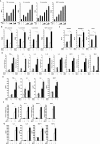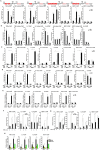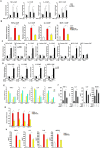MKL1 defines the H3K4Me3 landscape for NF-κB dependent inflammatory response
- PMID: 28298643
- PMCID: PMC5428227
- DOI: 10.1038/s41598-017-00301-w
MKL1 defines the H3K4Me3 landscape for NF-κB dependent inflammatory response
Abstract
Macrophage-dependent inflammatory response is considered a pivotal biological process that contributes to a host of diseases when aberrantly activated. The underlying epigenetic mechanism is not completely understood. We report here that MKL1 was both sufficient and necessary for p65-dependent pro-inflammatory transcriptional program in immortalized macrophages, in primary human and mouse macrophages, and in an animal model of systemic inflammation (endotoxic shock). Extensive chromatin immunoprecipitation (ChIP) profiling and ChIP-seq analyses revealed that MKL1 deficiency erased key histone modifications synonymous with transactivation on p65 target promoters. Specifically, MKL1 defined histone H3K4 trimethylation landscape for NF-κB dependent transcription. MKL1 recruited an H3K4 trimethyltransferase SET1 to the promoter regions of p65 target genes. There, our work has identified a novel modifier of p65-dependent pro-inflammatory transcription, which may serve as potential therapeutic targets in treating inflammation related diseases.
Conflict of interest statement
The authors declare that they have no competing interests.
Figures







Similar articles
-
MKL1 is an epigenetic mediator of TNF-α-induced proinflammatory transcription in macrophages by interacting with ASH2.FEBS Lett. 2017 Mar;591(6):934-945. doi: 10.1002/1873-3468.12601. Epub 2017 Mar 8. FEBS Lett. 2017. PMID: 28218970
-
MRTF-A mediates LPS-induced pro-inflammatory transcription by interacting with the COMPASS complex.J Cell Sci. 2014 Nov 1;127(Pt 21):4645-57. doi: 10.1242/jcs.152314. Epub 2014 Sep 4. J Cell Sci. 2014. PMID: 25189621
-
Acetylation of MKL1 by PCAF regulates pro-inflammatory transcription.Biochim Biophys Acta Gene Regul Mech. 2017 Aug;1860(8):839-847. doi: 10.1016/j.bbagrm.2017.05.006. Epub 2017 May 30. Biochim Biophys Acta Gene Regul Mech. 2017. PMID: 28571745
-
Coactivator-associated arginine methyltransferase-1 enhances nuclear factor-kappaB-mediated gene transcription through methylation of histone H3 at arginine 17.Mol Endocrinol. 2006 Jul;20(7):1562-73. doi: 10.1210/me.2005-0365. Epub 2006 Feb 23. Mol Endocrinol. 2006. PMID: 16497732
-
Epigenetic landscape of amphetamine and methamphetamine addiction in rodents.Epigenetics. 2015;10(7):574-80. doi: 10.1080/15592294.2015.1055441. Epigenetics. 2015. PMID: 26023847 Free PMC article. Review.
Cited by
-
Post-translational modifications in sepsis-induced organ dysfunction: mechanisms and implications.Front Immunol. 2024 Aug 21;15:1461051. doi: 10.3389/fimmu.2024.1461051. eCollection 2024. Front Immunol. 2024. PMID: 39234245 Free PMC article. Review.
-
The Omics Complexity in Sepsis: The Limits of the Personalized Medicine Approach.J Pers Med. 2024 Feb 20;14(3):225. doi: 10.3390/jpm14030225. J Pers Med. 2024. PMID: 38540968 Free PMC article. Review.
-
Targeting epigenetic mechanisms as an emerging therapeutic strategy in pulmonary hypertension disease.Vasc Biol. 2020 Jan;2(1):R17-R34. doi: 10.1530/vb-19-0030. Epub 2020 Jan 9. Vasc Biol. 2020. PMID: 32161845 Free PMC article.
-
MKL1 mediates TNF-α induced pro-inflammatory transcription by bridging the crosstalk between BRG1 and WDR5.J Biomed Res. 2019 Jun 4;33(3):164-172. doi: 10.7555/JBR.32.20170025. J Biomed Res. 2019. PMID: 29109331 Free PMC article.
-
Squeezing cells through the epigenetic machinery.Proc Natl Acad Sci U S A. 2018 Aug 21;115(34):8472-8474. doi: 10.1073/pnas.1811184115. Epub 2018 Aug 9. Proc Natl Acad Sci U S A. 2018. PMID: 30093390 Free PMC article. No abstract available.
References
-
- Natoli G. Specialized chromatin patterns in the control of inflammatory gene expression. Current topics in microbiology and immunology. 2011;349:61–72. - PubMed
Publication types
MeSH terms
Substances
LinkOut - more resources
Full Text Sources
Other Literature Sources

